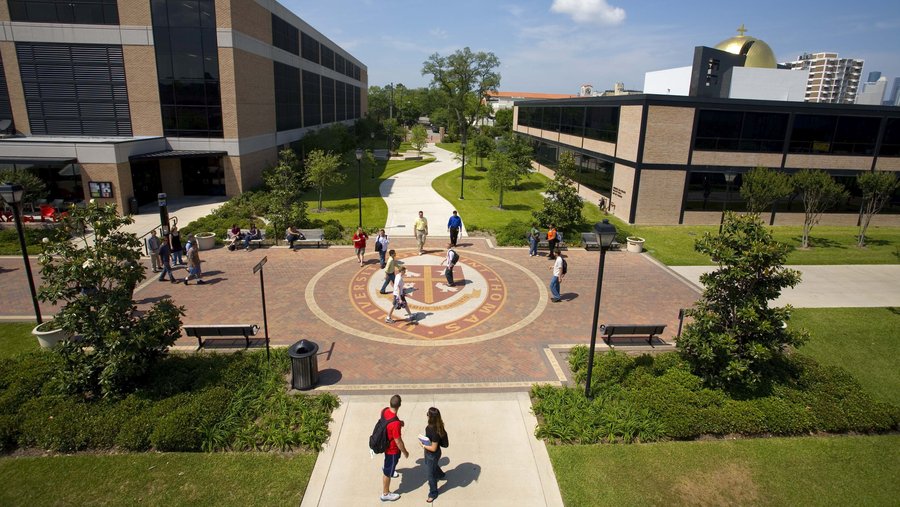H. E. Jenkins, chief of police at the University of St. Thomas, had to drive through the snow to get to campus Feb. 15 and 16. Jenkins, who pulls double duty overseeing the food halls at St. Thomas, tied on an apron and cooked for students himself.
Power outages, burst pipes, bad water pressure and freezing residential students were all part of what universities had to face when the winter storm enveloped Houston last week.
At St. Thomas, 80 of its usual 220 residential students remained on campus through the storm. Jenkins and other St. Thomas staff fed them twice a day, handed out water bottles and even considered firing up a grill before the power came back on.
St. Thomas largely consists of old converted Montrose homes, and nine of those 15 to 20 buildings were damaged due to burst pipes. The main buildings remained unscathed, Jenkins said, and several of those buildings that were damaged were on track for demolition anyway to make room for more residential halls.
Fellow private school Rice University didn’t sustain serious water damage, Kevin Kirby, vice president for administration, said in an internal letter Feb. 17.
Rice Village Apartments and Rice Graduate Apartments both suffered water and power issues, and some students there received temporary alternate housing.
Kirby compared Rice’s municipal services to that of a 12,000-person city, as the university has its own water well and generates most of its own power. Rice generated so much power during the storm it was able to supply CenterPoint Energy with its excess.
Through the early days of the storm, one-third of Rice's buildings were affected by the boil-water notice, while the rest were served by Rice’s water well and remained unaffected. Any pipes that broke were fixed by plumbing staff.
Food supplies remained regular, Kirby said, though the university converted to a weekend-style schedule of service, which means food halls were unable to sell food to those without a meal plan, and retail food options were closed.
“In the midst of these challenges, we were given many reasons to be grateful once more for the compassion and resilience of the Rice community,” Rice President Daviid Leebron said in a separate letter. “Dealing with these consequences of the winter freeze was made especially challenging by the omnipresent pandemic to avoid the risk of spreading the disease.
“And yet, we found ways to bring some students in our community who were living in intolerable circumstances to our campus, and made available warm places to work, showers and food for those who continued to live off campus but needed assistance.”
Leebron stated that Rice students served as blood donors to an unnamed local hospital, and Covid-19 vaccinations were given out to Rice community members when the vaccines were at risk of expiration. Harris County's health department gave Rice 800 doses of the Moderna vaccine after a back-up generator keeping them at the required temperature failed, KHOU reported.
At the University of Houston, a university representative said that it activated its emergency operations center on Feb. 14, which means liaisons from various university departments gathered virtually to handle issues as they arose.
UH had its worst problems Feb. 15, when its enterprise computer system went down, but it was restored by the end of the day. Most facilities retained power, though three residential facilities underwent rolling blackouts. UH moved any residents who lost power into another building. UH’s heat and water systems are connected, so some buildings lost heat because of the city's water pressure problems, even though they had power.
UH is in recovery now, looking at damage, though it doesn’t have a financial estimate yet. In addition, the storm delayed construction at both the in-progress College of Medicine and Law Center buildings. The university is still assessing how much those projects will be delayed, but it’s expected to be at least a week.
Jenkins, who started his post only two months before Hurricane Harvey, said the University of St. Thomas handled both Harvey and the winter storm well. St. Thomas gave to students in need after Harvey, replacing laptops or giving direct funds. Jenkins expects the university will do something similar after the winter storm.
“My chef kept bringing up one of the points I kept making to him, ‘I don’t know how we’re going to accomplish this, but we’re going to get this accomplished.’ (It was) my motto. There is no failure in feeding the students and getting them water. We’re going to get it done; we just have to just come up with plans,” Jenkins said.





